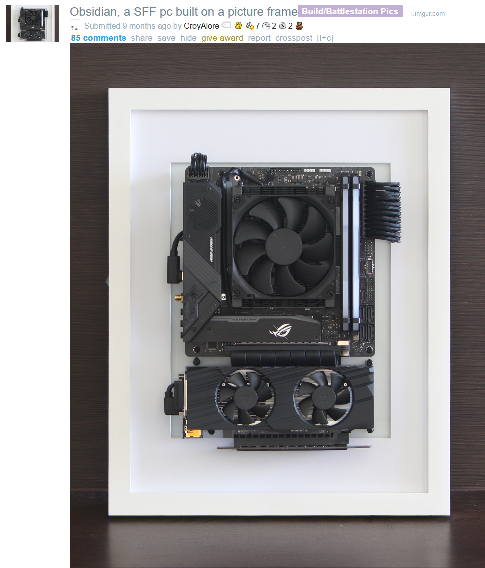2021 Computer Build Notes
25th July 2021
Some assorted notes from the process of building my computer, including some weak justifications.
PC Part Picker is great as it automatically determines compatibility and links to the cheapest provider. It also allows really good filters, i.e. NVMe M.2 drives per motherboard.
My Computer Specs
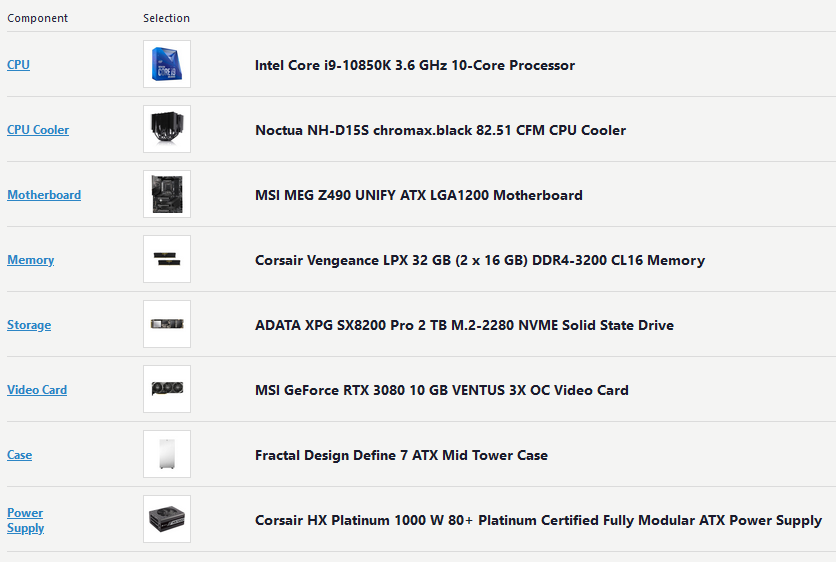
I ended up getting the 3080 founders edition by essentially being lucky as I happened to be staring at Discord at the time, and found an in-stock PSU on Corsair's site, making the completed parts list:
- Intel Core i9 10850k
- Noctua NH-D15S black
- MSI MEG Z490 UNIFY ATX
- 32GB RAM
- 2TB NVME M.2 SSD
- 3080 Founders Edition
- Fractal Design Define 7
- Corsair RMX 1000W Platinum
Justification
Goals
I wanted a lab machine (i.e. computer labs not labrador) which could virtualise "an office". With an estimate of a DC, potentially a second DC, a file / DHCP / etc server and some workstations. This meant that I'd really need a high core, or pseudo-core count, likely beyond the 6 or so one typically gets with i7's.
I also wanted to be able to virtualise, so needed some room for RAM (ideally with the option to upgrade later), and virtualise quickly (so NVME M.2 SSDs versus HDDs).
Gaming performance was a good bonus, but by meeting this main goal, all I'd need to do was add a GPU to round that off as the CPU is generally relevant but I'd essentially require a decent CPU anyway.
Furthering the future upgrade, I was considering (and still am considering) the option of adding HDDs etc to have a home NAS, so a case with space to expand the storage would also come in handy. Cases with more storage options naturally tend to be larger, which would also help with airflow.
CPU
As I wanted to virtualise, I needed cores as previously mentioned. For the stretch goal of gaming, really anything i5 or above was fine, but to be able to virtualise comfortably throughout the lifecycle of the machine, I'd want good capacity.
Intel vs AMD
The competition between the two predominant vendors is far closer this generation than it was previously. As my PC is a corona baby, my options essentially boiled down to "what is in stock" - at the time, the 10th generation i9s were in stock. The top tier i9, the 10900k was very good - but even cheaper was the 10850k, which had the same spec. Importantly, the 11th generation chips had just been released, but had lost two cores. So the 10-core 10850k won out.
Patience, if I possessed it, may have lead me to the AMD Ryzen 9. The AMD Ryzen series match broadly to the Intel - 9 is the best, 7 is great, 5 is solid, 3 works. The 5950x was current when I built my machine, but came at a roughly 50% higher price tag. While it has 16 cores (so 32 threads) to the i9 10850k's 10 cores (and 20 threads), I felt that 20 was enough, and that 32 didn't justify the price of £699.99, but could have been considered if I'd had a larger budget.
Naturally, these are all in stock now. I would avoid the 11th gen Intel - they launched in March, and the 12th gen is due to launch in September. This is far faster than usual, and I think it's because they got spooked by just how good the latest AMD chips are. Indeed, while they match Intel broadly, from the specs I've seen, the Ryzen 5 which is meant to compete in the same price bracket as the i5 has performance which actually matches the i7.
I think had I built my computer in 2022, it would be AMD all the way, and I'd have gone out of my way to save for the Ryzen 9. But as it was, an i9 is a fucktonne larger than the i7 mobile I was using, and at a very competitive price, with the 10850k at a £50 discount, which left me comfortable room to upgrade the standard CPU cooler to something with more teeth.
Cooler
The CPU cooler I went beyond on. So the i9 I bought no longer comes with coolers - lots of processors don't seem to these days. So I would have had to spend the money anyway, say £30 or £50. By adding the Noctua - well regarded even for overclocking an i9, I got some thermal headroom. A rule of thumb I found was that beyond 70oc parts degrade faster. My thoughts were thus that if I would be subjecting this CPU to moderately heavy usage, it's worth going with a decent cooler. This also unlocks the potential for overclocking in future, and compensates for the fact that recent Intel CPUs run hot.
Why not a water cooler
Frankly, I feel suspicious about all in one units, and I don't trust myself to make my own custom loop. Even though the chances of failure are very low, with an air cooler the only way my computer will get water in it is via my own ineptitude - a not insignificant risk, but at least it's reduced.
The Noctua DH-15s is competitive with water coolers when it comes to thermals, and can also have fans added at a later date for more whoosh1.
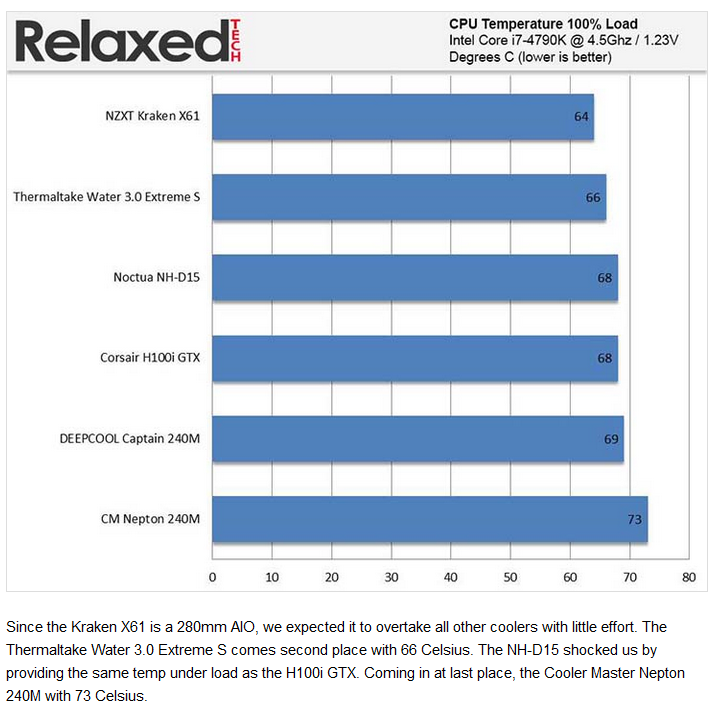
While this article is from a while ago, it demonstrates how the cooler can more than hold its own.
It's also, in my opinion, far quieter. I don't mind fan noise, but I hate rattles and machinery whining, which the pumps tend to add and which for whatever reason I specifically tune in to.
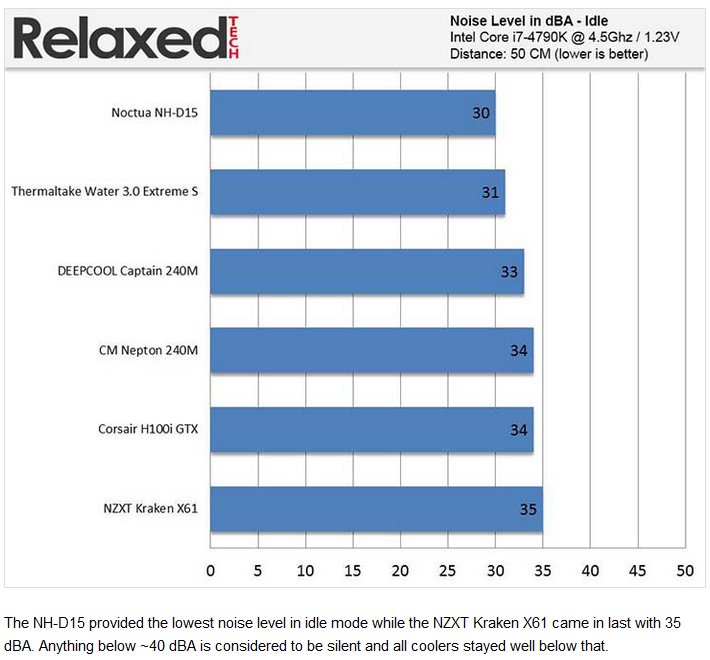
Actually, with sources from the article - it's already in a quiet bunch, but the air cooler is the quietest. Perhaps this is because the fans are centrally located, whereas water cooler radiators are mounted to the case sides.
Motherboard
I wanted to virtualise, and spin up machines quickly, and upgrade the machine in future. Gaming performance was also a consideration. My conclusion - get a motherboard with multiple NVME ports. I wanted three, which a small number had (the PC Part Picker filters work wonders here). I also opted for a motherboard with built-in WiFi and bluetooth, for easier internet access (I still haven't been bothered to run a cable in the new house) and headphone connectivity.
As I had already selected by CPU, I went for an Intel board (thanks again to PC Part Picker's auto compatibility) and hit the choice - do I get more RAM slots (but have to get a full size ATX case or a pricey board) or do I get less and get a nice bookshelf sized PC?
Small form factor or ATX?
Since I wanted longevity, while I love small form factor PC (SFFPC)s, I felt personally that the temperatures would be too high. The small form factor PCs I had seen routinely ran at high 60oC's when idling2 - mine now runs at 35oC idle and can hit 57oC under load. This will naturally increase the life span of the machine and components.
Thermals notwithstanding - SFFPCs are sexy as fuck3.
Choices
I ended up with the MSI MEG Unify - once I had filtered by my options of PCIE 4.0 (future proofing) and NVME, and added a stretch goal of wifi and bluetooth, it basically came down to colour.
It's worth keeping an eye on sockets - CPUs change their sockets which will require upgrading the motherboard. However, from my personal experience, when that happens I'm generally upgrading the whole PC anyway. Also worth mentioning is that Intel motherboards are PCI-E 4 ready - but the 10th generation chips are not. 11th generation and pretty much all AMD chips are. However, PCI-E 3 versus PCI-E 4 is barely noticable - with the 3000 series GPUs, it's like a 1% performance difference, which in my opinion is hardly worth bothering about. Since it increases the bus, one could argue that since I'm using, or plan to use, so many NVME drives it could have been worth holding off or settling for the 8 core 11th gen chip, but I will be using the drives to hold virtual machines, not continuously writing to them, and I don't game when I'm labbing. So, no impact.
Memory
I wanted to run VM's - 32 GB seemed good, then plenty of room to upgrade later with the 4 DIMM slots. DDR4 cause it works, AFAIK the speed doesnt seem to matter so I went with what my CPU and Motherboard supported. I had to faff in the BIOS since these days RAM comes at a speed the CPU considers overclocking, but this was mostly just a case of ticking "Yes" in the BIOS. YMMV.
Better to buy RAM in pairs and then fill the Motherboard outside, skip, second from the left. YMMV, that's just what the manual said.
It's RAM right? You can always download more so get what you need.
Storage
NVME drive. M.2 is the form factor - this is normally followed by a number which denotes the length. You'll want to pay attention to this as motherboard will generally not support the longer 10800 or whatever form factor. NVME is just a protocol but its computer components so everyone seems to use it interchangeably with M.2. As with the RAM, it's storage, get what you need.
NVME drives are roughly 10x faster than SATA. You can get pricier drives which themselves are 20x faster - but for me, a file going from 30 minutes to transfer to 3 is good enough - 30 minutes to 11/2? Less so if it has the price increase which it had at the time. Again, YMMV. It's storage.
Might be worth getting a boot drive, but since you can get 1TB NVME for a hundred now, you might as well just get a terabyte now and then you can add in another TB or 2TB stick when you upgrade as most boards have room for two, and you can always slot in expansions into the PCIE slots (although this will start to eat into your GPU bandwidth meaningfully).
GPU
Get the best you can afford tbh.
Case
So I wanted a case which supported upgrades - whether storage etc. I also wanted something quiet and A E S T H E T I C.
Since I'd sadly ruled out the SFFPCs, I was looking at my old favourite bitfenix or Fractal Design.
Finally, USB-C on the front was preferred.
https://www.fractal-design.com/
The Define and Meshify lines are very good - it was just cause I wanted to be bougie essentially that led me to the Define 7, but it has an added bonus as you can change the front layout to support more hard drives. The front panel is also hinged, meaning that when I am working quietly, I can leave it shut to deaden the sound; when gaming or being L33t, I can open the front panel to let in more air. It also comes with a second top panel to swap for more airflow.
Finally, it was just such a fucking nice case to build in. No jaggy edges, and the top completely unscrews to get the awkward CPU power in. I had one misaligned motherboard screw but a hammer solved that.
Power Supply
Save some money long term and get a good power supply, ideally 80+ platinum or minimum gold. Means you draw less power and save some money, and chances are if it's gotten that standard, its good.
Phanteks, Corsair, bequiet are all decent brands.
Fully modular will save you a lot of effort - just make sure that GPUs with multiple PCI-E power have each port its OWN line from the PSU - these days they draw so much you SHOULD NOT daisy chain them.
If you go Corsair, you want to get either their RMX or RMI as these have better capacitors. Honestly, mine has been a pain; I'd always dismissed coil whine til I got mine and the PC started singing to me.
Don't cheap out - no other component has the power to kill the rest like the PSU. Get a known brand with good reviews. I'd steer clear of PSUs that are newly released; they age just fine since the power is all standardised (this is actually changing slowly, vendors are upgrading the motherboard power).
Posed Photo
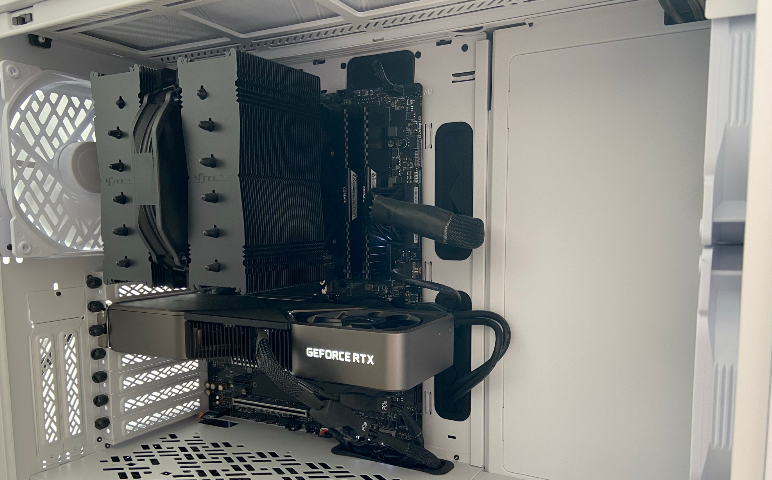
Naturally, I also colour-coordinated the whole thing.

